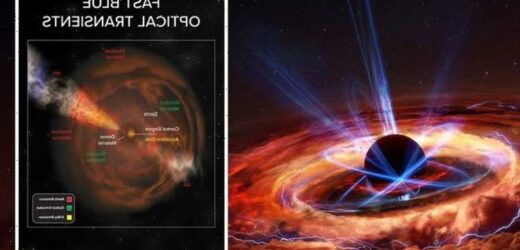Supernova: Simulation shows elements in exploding star
We use your sign-up to provide content in ways you’ve consented to and to improve our understanding of you. This may include adverts from us and 3rd parties based on our understanding. You can unsubscribe at any time. More info
The prehistoric blast, which astronomers detected in October 2020, appeared without warning and vanished from the night skies within a month. But even long after its light was no longer visible from Earth, the eruption left behind an intense afterglow of radio and X-ray radiation. To date, scientists have only observed three other similar events, two of which have been given unusual names – “the Cow” and “the Koala”.
The newest explosion has been named “the Camel” as a play on words of its official name, ZTF20acigmel.
Astronomers attribute these explosions to some form of high-energy cosmic phenomena.
They are quick, energetic and extremely hard to catch because of how rapidly they fade away.
Astronomers officially call them fast blue optical transients or FBOTs as they give off a blue glow and strong radiation signals.


According to one theory, the intense but short-lived explosions are the product of a black hole or neutron star being born.
It is, however, clear they are not supernovas, which are the biggest cosmic fireworks known to science.
The Camel’s discovery was described in a paper that is yet to be peer-reviewed but was published on the pre-print server arXiv.
The study’s authors wrote: “Our work suggests that luminous millimeter, radio, and X-ray emission are a generic feature of transients with fast and luminous optical light curves.”
According to the research, the Camel erupted from its unknown source at speeds of more than 100 million miles per hour.
NASA: Hubble telescope captures fading supernova in NGC 2525
Such intense bursts of radio emissions are typically attributed to so-called synchrotron radiation, which occurs when particles are accelerated around a curved path.
In space, these can happen when stellar material circles a black hole.
On Earth, scientists have built circular synchrotron accelerators that send protons or electrons around a track in the presence of a powerful electric field.
The 17 mile-long Large Hadron Collider (LHN) at CERN, for example, is the world’s biggest synchrotron-type accelerator.


In May 2020, astronomers reported the detection of an FBOT some 500 million light-years from Earth that they named CRTS-CSS161010 (CSS).
The event occurred in 2016 and was described as faster and brighter than any other observed FBOT.
According to Deanne Coppejans, who led a study describing the event, the explosion erupted up to 10 percent of the mass of our Sun, indicating scientists had stumbled upon a new class of cosmic phenomena.
He said: “This was unexpected… We know of energetic explosions that can eject material at almost the speed of light, specifically gamma ray bursts, but they only launch a small amount of mass – about one-millionth the mass of the Sun.
“CSS161010 launched one to 10 percent the mass of the Sun at more than half the speed of light – evidence that this is a new class of transient.”
Two years prior, astronomers detected the Cow or AT2018COW, about 200 million light-years away from Earth.
In May this year, astronomers also described the discovery of the Koala in a galaxy about 3.4 billion light-years away.
Anna Ho, of the California Institute of Technology (Caltech) said of the discovery: “When I reduced the data, I thought I had made a mistake.”
Source: Read Full Article


